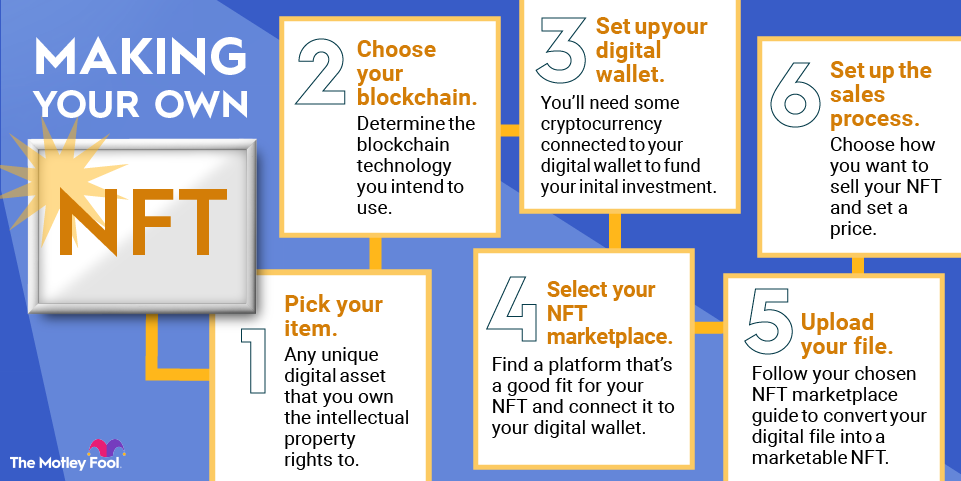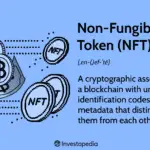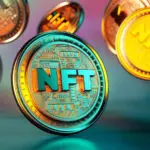To make an NFT, create digital art and mint it on a blockchain platform like Ethereum. Use an NFT marketplace to list and sell your creation.
Creating NFTs has become a popular way for artists to monetize their digital work. NFTs, or non-fungible tokens, are unique digital assets verified using blockchain technology. They represent ownership of digital items such as art, music, and videos. The process involves creating digital content, minting it into an NFT, and listing it on an NFT marketplace.
Popular platforms for minting include Ethereum, Binance Smart Chain, and Polygon. Once minted, the NFT can be sold or traded, providing artists with new revenue streams. Understanding the basics of blockchain and choosing the right marketplace are crucial for success in the NFT space.
Introduction To Nfts
In the digital age, NFTs have emerged as a game-changer. They are unique digital assets that represent ownership. Artists, gamers, and investors are keen on them.
What Are Nfts?
NFTs stand for Non-Fungible Tokens. They are digital assets on a blockchain. Unlike cryptocurrencies, they are unique. One NFT cannot be exchanged for another.
NFTs can be anything digital. They can be art, music, or even tweets. They are stored on a blockchain, ensuring ownership.
Why Nfts Are Popular
NFTs have gained popularity for several reasons:
- Unique Ownership: Each NFT is one-of-a-kind.
- Digital Collectibles: People love collecting rare items.
- Value Appreciation: NFTs can increase in value over time.
- Support for Artists: Artists can sell their work directly.
| Feature | Description |
|---|---|
| Unique | Each NFT is unique and cannot be replicated. |
| Blockchain | NFTs are stored on a blockchain, ensuring security. |
| Ownership | Ownership is verifiable and cannot be altered. |

Choosing The Right Platform
Choosing the right platform is crucial for creating an NFT. The platform determines your NFT’s visibility and potential market reach. Let’s explore popular NFT marketplaces and compare their features.
Popular Nft Marketplaces
- OpenSea: OpenSea is one of the largest NFT marketplaces. It supports a wide variety of digital assets.
- Rarible: Rarible allows creators to mint and sell their NFTs. It has a user-friendly interface.
- Foundation: Foundation focuses on digital art. It offers a curated marketplace for artists.
- Mintable: Mintable is easy to use. It offers both a gasless and traditional minting option.
- SuperRare: SuperRare is known for its exclusive and high-quality digital art.
Comparing Platforms
| Platform | Key Features | Best For |
|---|---|---|
| OpenSea | Wide variety of digital assets, large user base | General NFTs, high visibility |
| Rarible | User-friendly, supports community governance | New creators, community-driven projects |
| Foundation | Curated marketplace, digital art focus | Professional artists, art collectors |
| Mintable | Gasless minting, easy to use | Beginners, cost-conscious creators |
| SuperRare | Exclusive, high-quality digital art | Serious collectors, high-end art |
Each platform has its strengths. Choose one that fits your needs. Consider your target audience and the type of NFT you want to create.
Setting Up A Digital Wallet
Creating an NFT starts with setting up a digital wallet. This wallet will store your NFTs and cryptocurrencies. Understanding the process ensures the safety of your assets.
Types Of Wallets
There are different types of digital wallets. Each has its benefits and drawbacks. Here are the main types:
- Hardware Wallets: These are physical devices. They store your private keys offline. Examples include Ledger and Trezor.
- Software Wallets: These are applications on your device. They are convenient but less secure. Examples include MetaMask and Trust Wallet.
- Web Wallets: These operate through your browser. They are easy to use but more vulnerable. Examples include MyEtherWallet and Coinbase Wallet.
Securing Your Wallet
Security is crucial for your digital wallet. Here are some tips to keep it safe:
- Use Strong Passwords: Create a unique and complex password. Avoid common words and phrases.
- Enable Two-Factor Authentication (2FA): This adds an extra layer of security. Use apps like Google Authenticator.
- Backup Your Wallet: Store your recovery phrase in a safe place. Do not share it with anyone.
- Keep Software Updated: Regularly update your wallet software. This ensures you have the latest security features.
- Avoid Public Wi-Fi: Do not access your wallet on public networks. Use a secure and private internet connection.
Following these steps will help protect your digital wallet. This ensures the safety of your NFTs and cryptocurrencies.

Buying Cryptocurrency
To create an NFT, you need cryptocurrency. Buying cryptocurrency is the first step. This section will guide you through selecting and purchasing crypto.
Selecting A Cryptocurrency
First, choose the right cryptocurrency for your NFT. Many use Ethereum (ETH). It’s popular and widely accepted. Other options include Binance Coin (BNB) and Flow (FLOW). Choose based on your needs and the platform you will use.
Where To Buy Crypto
You can buy cryptocurrency from exchanges. Popular exchanges include:
- Coinbase: User-friendly and great for beginners.
- Binance: Offers many cryptocurrencies and low fees.
- Kraken: Known for its security features.
- Gemini: Regulated and secure.
Follow these steps to buy crypto:
- Create an account on your chosen exchange.
- Verify your identity with a government ID.
- Deposit funds using a bank transfer or credit card.
- Buy your selected cryptocurrency.
- Transfer the crypto to your digital wallet.
Now you are ready to use your crypto to create NFTs!
Creating Your Digital Art
Creating digital art is the first step to making an NFT. Your digital art will be unique, and you can sell it as a non-fungible token. This section will guide you through the tools and tips needed to create stunning digital art.
Tools For Digital Art
Choosing the right tools is essential for creating digital art. Below are some popular tools:
- Adobe Photoshop: A powerful tool for detailed artwork.
- Procreate: Great for iPad users with many features.
- Corel Painter: Offers realistic painting techniques.
- GIMP: A free alternative to Photoshop.
- Blender: Best for 3D art and animations.
Tips For Beginners
Starting with digital art can be exciting yet challenging. Here are some tips to help you:
- Start Simple: Begin with basic shapes and lines.
- Use Tutorials: Follow online tutorials to learn techniques.
- Practice Daily: Consistent practice improves skills.
- Experiment: Try different tools and styles to find what you love.
- Seek Feedback: Share your work and ask for constructive criticism.
Creating digital art is a fun and rewarding process. With the right tools and tips, you can create art that stands out. Keep practicing and exploring new techniques to improve your skills.

Minting Your Nft
Minting your NFT involves converting your digital file into a blockchain asset. This process makes your digital art unique and verifiable. Minting is the first step to selling or trading your NFT. Let’s walk through the steps to mint your NFT and understand the associated costs.
Steps To Minting
- Create a Digital Wallet: You need a digital wallet to store cryptocurrencies and NFTs. MetaMask and Trust Wallet are popular options.
- Purchase Cryptocurrency: Buy Ethereum (ETH) or the cryptocurrency used by your chosen platform. You can purchase it on exchanges like Coinbase or Binance.
- Choose an NFT Platform: Select a platform to mint your NFT. OpenSea, Rarible, and Mintable are user-friendly options.
- Upload Your Digital File: Upload your digital artwork, music, or document. Ensure the file meets the platform’s requirements.
- Fill in NFT Details: Provide a title, description, and any other relevant details. This information helps potential buyers understand your NFT.
- Mint Your NFT: Click the mint button. The platform will convert your file into an NFT on the blockchain.
- Pay Gas Fees: Pay the required gas fees for the minting process. These fees vary based on network congestion.
- List Your NFT for Sale: Once minted, you can list your NFT for sale on the marketplace. Set your price and wait for buyers.
Associated Costs
Minting an NFT involves several costs. Here is a breakdown of the common expenses:
| Cost Type | Estimated Amount |
|---|---|
| Digital Wallet Setup | Free |
| Cryptocurrency Purchase | Varies |
| Platform Fees | $10 – $100 |
| Gas Fees | $30 – $100 |
| Listing Fees | Varies |
These costs are estimates and can fluctuate. Always check current fees on your chosen platform. Budget accordingly to ensure a smooth minting process.
Listing Your Nft For Sale
Listing your NFT for sale is an exciting part of the process. It’s where you decide how much your digital artwork is worth. This section will guide you through the steps to list your NFT. Follow these steps to make your NFT available for buyers.
Setting A Price
Setting the price of your NFT is crucial. You can set a price based on the current market trends. Research similar NFTs to find the right price. Consider the uniqueness and rarity of your NFT. Here are some tips for setting the price:
- Look at recent sales of similar NFTs.
- Consider the time and effort you put into creating the NFT.
- Think about the long-term value of your NFT.
Be realistic about your expectations. Setting the right price can attract more buyers.
Choosing Auction Or Fixed Price
You can choose between auction and fixed price for selling your NFT. Each method has its benefits. Choose the one that suits your needs the best.
Auction
An auction lets buyers bid on your NFT. The highest bid wins the NFT. Auctions can create excitement and competition among buyers. Here’s how to set up an auction:
- Choose the starting price for your auction.
- Set a duration for the auction.
- Decide if you want a reserve price.
Auctions can drive up the price of your NFT. They are great for unique and high-demand NFTs.
Fixed Price
A fixed price means you set a specific price for your NFT. Buyers can purchase it immediately at that price. Fixed prices offer certainty and simplicity. Here are the steps to set a fixed price:
- Decide the exact price for your NFT.
- List your NFT on the marketplace.
- Wait for a buyer to purchase your NFT.
Fixed prices are good for quick sales. They are ideal if you want a specific amount for your NFT.
Promoting Your Nft
Creating an NFT is just the beginning. Promoting it ensures visibility and sales. An effective promotion strategy is crucial. Here are some methods to help you.
Using Social Media
Social media is a powerful tool to promote your NFT. Platforms like Twitter, Instagram, and Facebook have vast audiences. Share your NFT on these platforms to reach more people.
- Twitter: Use relevant hashtags. Engage with the NFT community.
- Instagram: Post eye-catching visuals. Use stories and reels.
- Facebook: Join NFT groups. Share your NFT in these groups.
Engaging with your audience is key. Reply to comments and messages. This helps build a loyal following. Consistent posting keeps your audience interested.
Collaborating With Influencers
Influencers have large followings. Collaborating with them can boost your NFT’s visibility. Choose influencers in the NFT space. Their audience is more likely to be interested in your NFT.
You can offer influencers your NFT for promotion. They can share it with their followers. This can lead to more views and potential sales.
| Platform | Strategy | Benefit |
|---|---|---|
| Use hashtags | Increases reach | |
| Post visuals | Attracts attention | |
| Join groups | Engages community |
Remember, promotion is ongoing. Keep engaging with your audience. This helps maintain interest in your NFT.
Managing Your Nft Portfolio
Managing your NFT portfolio is crucial for success. Proper management helps you track sales and plan future strategies.
Tracking Sales
Effective tracking of sales is essential. It lets you monitor your NFT’s performance.
- Use platforms like OpenSea or Rarible.
- Check your sales history regularly.
- Note the dates and prices of your sales.
- Analyze patterns and trends in your sales data.
Tracking sales helps you understand market demands. It also helps you identify which NFTs are popular.
Future Strategies
Planning future strategies ensures your portfolio grows. Use data from your sales to make informed decisions.
- Set clear goals for your NFT portfolio.
- Diversify your NFT assets.
- Keep up with market trends and news.
- Adjust your strategies based on performance data.
Future strategies help you stay ahead. They ensure you make smart investments in NFTs.
| Goal | Action |
|---|---|
| Increase Sales | Promote NFTs on social media |
| Diversify Portfolio | Invest in different types of NFTs |
| Stay Updated | Follow NFT market trends |
Use these tips to manage your NFT portfolio effectively. It will help you achieve long-term success.
Conclusion
Creating an NFT can be simple with the right steps. Follow this guide for a seamless experience. Start by choosing a platform, then create and mint your digital asset. Finally, list and promote your NFT to reach potential buyers. Embrace the digital future and explore the endless possibilities of NFTs.


